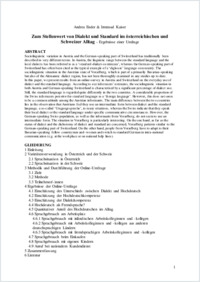Zum Stellenwert von Dialekt und Standard im österreichischen und Schweizer Alltag – Ergebnisse einer Umfrage
BLE-BLL
- Ender, Andrea University of Bern
- Kaiser, Irmtraud University of Fribourg
-
02.03.2009
English
Sociolinguistic variation in Austria and the German-speaking part of Switzerland has traditionally been described in very different terms. In Austria, the linguistic range between the standard language and the local dialects has been referred to as a ‘standard-dialect-continuum’, whereas the German-speaking part of Switzerland has often been cited as the typical example of a ‘diglossic’ language community. The sociolinguistic situation in the Austrian state of Vorarlberg, which is part of a primarily Bavarian-speaking but also of the Alemannic dialect region, has not been thoroughly examined in any studies up to date. In this paper, we present results from an online-survey in Austria and Switzerland on the everyday use of dialect and the standard language. According to our informants’ estimates, the sociolinguistic situation in both Austria and German-speaking Switzerland is characterised by a significant percentage of dialect use. Still, the standard language is regarded quite differently in the two countries. A considerable proportion of the Swiss informants perceive the standard language as a ‘foreign language’. However, this does not seem to be a common attitude among the Austrian informants. The main difference between the two countries lies in the observation that Austrians feel they use an intermediate form between dialect and the standard language, a so-called ‘Umgangssprache’, in many situations, whereas the Swiss indicate that they speak their local dialect or the standard language under specific communicative circumstances. However, the German-speaking Swiss population, as well as the informants from Vorarlberg, do not seem to use an intermediate form. The situation in Vorarlberg is particularly interesting. On the one hand, as far as the status of dialect and the dichotomy of dialect and standard are concerned, Vorarlberg patterns similar to the German-speaking part of Switzerland. On the other hand, people from Vorarlberg have to adapt to their Bavarian-speaking fellow countrymen and -women and switch to standard German in intra-national communication (e.g. at the workplace or on national help lines).
- Faculty
- Faculté des lettres et des sciences humaines
- Department
- Département de plurilinguisme et didactique des langues étrangères
- Language
-
- German
- Classification
- Language, linguistics
- License
-
License undefined
- Identifiers
-
- RERO DOC 22281
- Persistent URL
- https://folia.unifr.ch/unifr/documents/301962
Statistics
Document views: 243
File downloads:
- authors' version: 449
